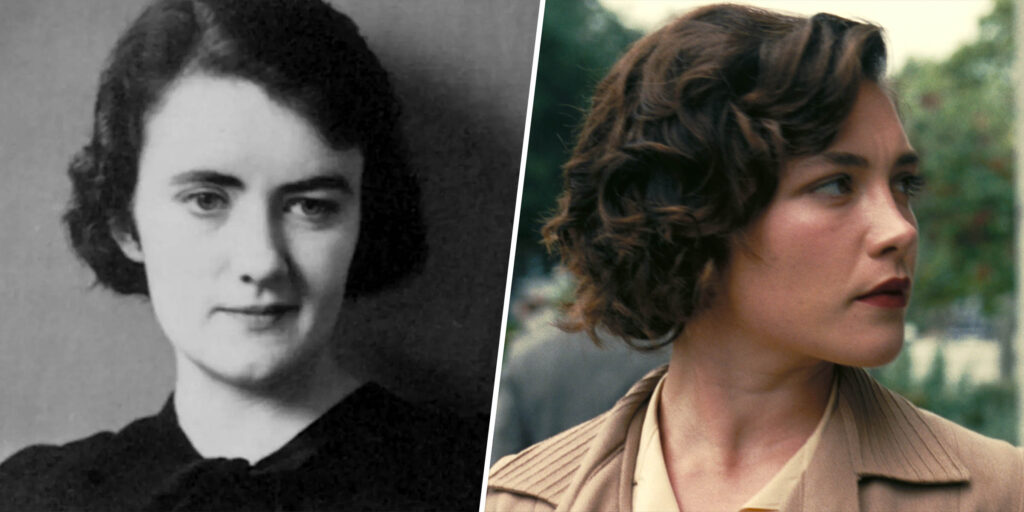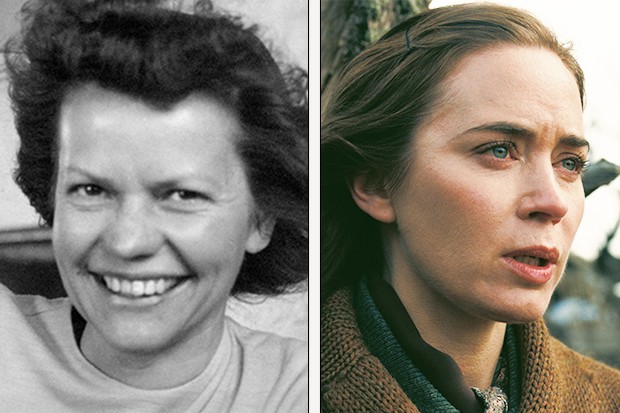Though captivating with an amusing soundtrack and astonishing visuals, Oppenheimer ended up being a controversial release in 2023 for its lack of accurate female representation and failure of the Bechdel Test.
If you don’t know what a Bechdel Test is, you can click here.
This movie has been judged for its misogyny and many viewers try to justify it by claiming the 1940s were a time difficult for women in STEM. For example, Liz Hallock in Princeton Alumni Weekly mentions “The audience is already aware that women of that era were marginalized. But here there were at least two incredible characters Nolan failed to further develop, who broke barriers by studying in the sciences, but are memorialized in the film as accessories of a ‘great’ man and take of misogyny (Hallock, 2023)”.
Female characters in the movie are objectified and sexualized. The sole purpose of their existence is to help Robert Oppenheimer’s (interpreted by Cillian Murphy) story develop. Florence Pugh’s character is based on a real historical character, Jean Tatlock, an American doctor, psychiatrist, Stanford School of Medicine graduate, member of the Communist Party, and reporter and writer for the Western Worker. She succeeded in the science field at a time and place where women were hardly respected and included. Nevermore, her portrayal in the film was nothing more but a desperate, deeply disturbed, communist, mistress. She did struggle with depression and uncertainty about her own sexuality, but she was only shown to have committed suicide from a lack of attention and an un-corresponded love from Oppenheimer. The script made it look like she couldn’t live without the presence of her lover, almost like Mercedes Sosa’s song, Alfonsina y el Mar. While it seems like a poetic forbidden love story, it’s not real. She was suspected to have committed suicide, but it was never confirmed, and it is also very sexist to think that a woman’s biggest ambition is to find love and if she doesn’t find it, then she will lose all hope.
Jean Tatlock’s depression could’ve been related to something bigger than a lover, like the socio-political environment of the 1940s. Around that time, Americans were still facing the consequences of the Great Depression. Most of the population was earning around 2,000 dollars a year. Unemployment was on the rise, there was a lack of basic goods, and there was a lot of post-traumatic stress after the First World War and the events of World War II. Women were expected to fulfill the role of housewives and mothers, yet as soon as men went to fight in the war, they were also expected to cover factory jobs. A decade later, according to Chris Millard in the National Library of Medicine, an epidemic in self-harm was finally declared. Even Oppenheimer’s second child, Katherine Oppenheimer, also committed suicide in the 70s when she was 32 years old. If that is not enough context to understand the rise of suicide in the XXth century, Robert Serber worked alongside Oppenheimer in The Manhattan Project, and his wife, Charlotte, also committed suicide in 1967.

Jean Tatlock was mostly shown naked and having intercourse with Oppenheimer. We can fully see her breasts without censure, and it might be an intention to normalize women’s nipples as part of a progressive narrative, but it is not because we can only see her breasts if she’s having sex with Oppenheimer or having an after-sex conversation. A woman who surpassed limits, who had an intriguing life, and whose story could help modern-day people understand the XXth century, was only given dialogues about her sexual activities with Robert Oppenheimer.
Per contra, Emily Blunt’s character, Katherine Oppenheimer, is mainly presented as a drunk mother. She is also based on a real historical character, a German biologist, botanist, and member of the US Communist Party. Ultimately, she became an alcoholic who because of the recurrent mix of cigarettes, pills, and alcohol had pancreatitis several times. However, she was more than a woman with alcoholism, and none of that was shown in the film. She worked with physicist, Charles Lauritsen, at the X-Ray laboratory at the California Institute of Technology (Caltech), where Robert because he was teaching at Caltech. Then she worked as a laboratory assistant at the University of California, and she even worked in the Manhattan Project for the director of the Health Group at Los Alamos conducting blood tests to evaluate the danger of radiation.

In the movie, Oppenheimer is presented as the savior of his children. He takes them out of the house and leaves them under his friends’ care, who will do a better job than their “drunk” mother. What really happened was Robert and Kitty traveled to the Caribbean because their daughter got sick with Polio and needed a warm environment to recuperate.
This is all we see from the female characters. Their storyline was written so they were only relevant to the male protagonist’s arc. The film didn’t even mention the Calutron Girls, who were around 10,000 young women who worked in the “Little Boy” bomb development. They worked on separating uranium 235 from uranium 238 so it would work as fuel for the bomb. These women were working in a secret community of 75,000 workers, and none of them were told they were working on a bomb that would injure and kill around 100,000 innocent people in Japan. Many people who tried asking and finding out what they were working for, mysteriously disappeared. Ruth Hiddleston, one of the Calutron Girls, remembered her feelings after finding out what she was working for and spoke:
“I was at work and they announced it, you know. At first you were glad to think the war was over. The first thing I thought was ‘my boyfriend will be home.’ Then I got to thinking, they start telling all the people that were killed over there. It made you think of something else, that I had a part in it, because that’s what they told us. They said it’s been dropped there, and then they said so many thousands or a million or whatever—I don’t remember. Anyway, I didn’t much like that idea that I had a part in it. But you know, war is war. Ain’t nothing you can do about it but try to stop it. I still don’t like the idea, you know. But you’ve got to do it. Somebody does. (Hiddleston in National Park Service, 2023)”.
I know this film is not biographical. I know it is inspired by true events, but how misogynistic do you have to be to ignore hundreds of women who played an important role in the story from which you took inspiration? I respect Christopher Nolan’s work. He has created several outstanding films that deepen on male emotions and how men experience feelings, which are also commonly disregarded in cinema and society overall. He is also one of the pioneers of post-modern cinema. Nonetheless, he could use those narration abilities to portray how women feel deep and complex sentiments in the same way he does with his male characters.
Ironically, the movie was released on the same date as Barbie. Barbie criticizes the power struggle between women and men in society. It uses Ken to depict how would women objectify men for their personal interests while Oppenheimer does the same thing in a real script and not from a hypothetical perspective.
Thousands of men have openly spoken against Barbie in all social media for its unfair and mysandric use of men. But how many of those men have said anything about the way women are depicted in Oppenheimer? Oppenheimer is one of the thousands of examples that prove how male writers mainly build female characters in a way that only constructs the male character’s development without allowing women’s autonomy, free choice, and individual mindset to reveal themselves.
This is an example of why many women prefer to watch movies or shows written with a female gaze. Not because it’s only written by another woman, but because, most of the time, it accurately depicts how women’s train of thought evolves.
BIBLIOGRAPHY
Hallock, Liz. (2023). When Will Our Culture Stop Lionizing Womanizers in Film? Princeton Alumni Weekly. Available in https://paw.princeton.edu/inbox/when-will-our-culture-stop-lionizing-womanizers-film
Millard, Chris. (2015). Chapter 1 Early Twentieth-Century Self-Harm: Cut Throats, General and Mental Medicine. National Library of Medicine. Available in https://www.ncbi.nlm.nih.gov/books/NBK333534/
National Park Service. (2023). The Calutron Girls. National Park Service. Available at https://www.nps.gov/articles/000/the-calutron-girls.htm
Wellerstein, Alex. (2020). Counting the Deat at Hiroshima and Nagasaki. Bulletin of the Atomic Scientists. Available in https://thebulletin.org/2020/08/counting-the-dead-at-hiroshima-and-nagasaki/






Your article helped me a lot, is there any more related content? Thanks!
Thank you for your sharing. I am worried that I lack creative ideas. It is your article that makes me full of hope. Thank you. But, I have a question, can you help me?
Thanks for sharing. I read many of your blog posts, cool, your blog is very good.